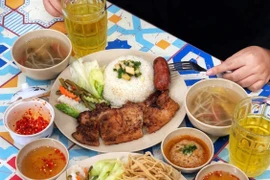 Traditional sour fish soup is a favourite dish among people in their daily meals, particularly in the summer. (Photo: congly.vn)
Traditional sour fish soup is a favourite dish among people in their daily meals, particularly in the summer. (Photo: congly.vn)Sour fish soup is a common name for a number of Vietnam's specific fish soupsthat feature a harmonious combination of sweet, sour, and peppery flavours. Thesoup broth is often cooked with tamarind, pineapple, tomato, okra, green beansprouts and other vegetables. The fish used include catfish, carp, snakeheadfish, salmon and others. The cooked soup is often topped with fresh onion,cilantro and other herbs. It is typically eaten with rice, TasteAtlas said.
In the northern region, sour fish soup is cooked with dracontomelon or fruit ofa plant named 'Garcinia cowa', or qua doc inVietnamese. Sugar is not used in order to preserve the natural flavour of theingredients.
Meanwhile, cooks in the country's southern and southwestern regions often addsome sugar to the soup along with very hot chilli, said professional chef PhamTuan Hai, one of the judges of the Vietnam Master Chef Programme. He added thatalthough each region has its own recipe to cook the dish, the completed dishmaintains a lightly sweet and sour flavour from cooked ingredients such asfruits and aromatic herbs.
Hai recalled that he would never forget the special taste and aromatic flavourof the soup cooked by his grandmother during his childhood. It was also during Vietnam’swar and post-war periods when most local households were poor, so having a bowlof sour fish soup was a great effort by his grandmother.
"My grandmother cooked the dish once a week during summer time,particularly on severely hot days to help us increase our resistance to theheat.
"Like other northern cooks, my grandmother would often buy a freshsnakehead fish and fry it before cooking it with one or two dọc fruits.She would grill the fruits until they became yellow, then peel off their skinto cook the dish. I helped my grandmother by cutting banana flowers intopieces, soaking them in water, and washing the fresh herbs," said Hai.
To make the dish fragrant, his grandmother cleaned the fish very carefully withsalt, lime juice or white wine to eliminate the fishy smell. She cut the fishinto three or four parts before marinating it with fish sauce, broth mix, andspice for half an hour, he said.
"My grandmother would fry the dried onion in cooking oil for a while, thenadd tomato pieces, dọc fruitsand fish into a pot of boiling water over medium heat and cook it for 10minutes. She also ground fresh turmeric to extract its juice to add to the pot beforeturning off the heat," Hai said.
He added that when his grandmother scooped the fish soup into a big bowl, itwas very attractive: the fish was a light yellow colour, surrounded by redtomato pieces and topped with green onions and fresh herbs. It was served witha bowl of sauce made from a bit of sugar, minced garlic, and fresh chilli cutinto pieces.
"We enjoy the dish so much for its natural sweetness and sourness from thefruits and herbs, particularly the fragrance from the cilantro. The dish givesus a very good appetite to finish our meal despite the heat," Hai said.
In modern days, despite the much-improved living standards of the people,traditional sour fish soup is still most chosen not only in the summer, butalso in the winter to warm the body.
According to their taste, they choose different fish, such as carp, to cookwith sour bamboo or the thick and fleshy taro petioles, often eaten with ricenoodles. These variations are also very enjoyable, Hai noted./.




























